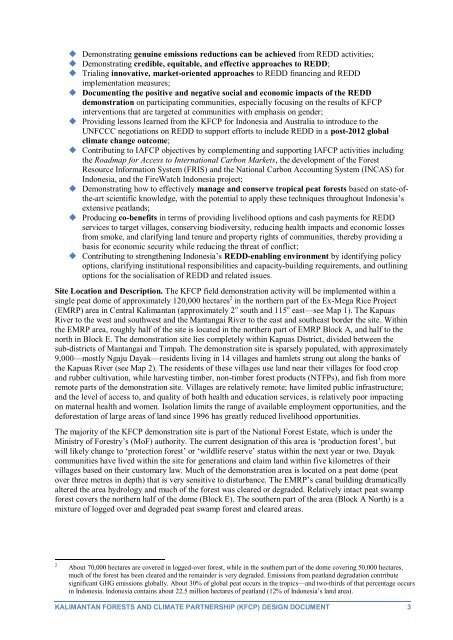Kalimantan Forests and Climate Partnership (KFCP) Design ...
Kalimantan Forests and Climate Partnership (KFCP) Design ...
Kalimantan Forests and Climate Partnership (KFCP) Design ...
You also want an ePaper? Increase the reach of your titles
YUMPU automatically turns print PDFs into web optimized ePapers that Google loves.
Demonstrating genuine emissions reductions can be achieved from REDD activities;<br />
Demonstrating credible, equitable, <strong>and</strong> effective approaches to REDD;<br />
Trialing innovative, market-oriented approaches to REDD financing <strong>and</strong> REDD<br />
implementation measures;<br />
Documenting the positive <strong>and</strong> negative social <strong>and</strong> economic impacts of the REDD<br />
demonstration on participating communities, especially focusing on the results of <strong>KFCP</strong><br />
interventions that are targeted at communities with emphasis on gender;<br />
Providing lessons learned from the <strong>KFCP</strong> for Indonesia <strong>and</strong> Australia to introduce to the<br />
UNFCCC negotiations on REDD to support efforts to include REDD in a post-2012 global<br />
climate change outcome;<br />
Contributing to IAFCP objectives by complementing <strong>and</strong> supporting IAFCP activities including<br />
the Roadmap for Access to International Carbon Markets, the development of the Forest<br />
Resource Information System (FRIS) <strong>and</strong> the National Carbon Accounting System (INCAS) for<br />
Indonesia, <strong>and</strong> the FireWatch Indonesia project;<br />
Demonstrating how to effectively manage <strong>and</strong> conserve tropical peat forests based on state-ofthe-art<br />
scientific knowledge, with the potential to apply these techniques throughout Indonesia‘s<br />
extensive peatl<strong>and</strong>s;<br />
Producing co-benefits in terms of providing livelihood options <strong>and</strong> cash payments for REDD<br />
services to target villages, conserving biodiversity, reducing health impacts <strong>and</strong> economic losses<br />
from smoke, <strong>and</strong> clarifying l<strong>and</strong> tenure <strong>and</strong> property rights of communities, thereby providing a<br />
basis for economic security while reducing the threat of conflict;<br />
Contributing to strengthening Indonesia‘s REDD-enabling environment by identifying policy<br />
options, clarifying institutional responsibilities <strong>and</strong> capacity-building requirements, <strong>and</strong> outlining<br />
options for the socialisation of REDD <strong>and</strong> related issues.<br />
Site Location <strong>and</strong> Description. The <strong>KFCP</strong> field demonstration activity will be implemented within a<br />
single peat dome of approximately 120,000 hectares 2 in the northern part of the Ex-Mega Rice Project<br />
(EMRP) area in Central <strong>Kalimantan</strong> (approximately 2 o south <strong>and</strong> 115 o east—see Map 1). The Kapuas<br />
River to the west <strong>and</strong> southwest <strong>and</strong> the Mantangai River to the east <strong>and</strong> southeast border the site. Within<br />
the EMRP area, roughly half of the site is located in the northern part of EMRP Block A, <strong>and</strong> half to the<br />
north in Block E. The demonstration site lies completely within Kapuas District, divided between the<br />
sub-districts of Mantangai <strong>and</strong> Timpah. The demonstration site is sparsely populated, with approximately<br />
9,000—mostly Ngaju Dayak—residents living in 14 villages <strong>and</strong> hamlets strung out along the banks of<br />
the Kapuas River (see Map 2). The residents of these villages use l<strong>and</strong> near their villages for food crop<br />
<strong>and</strong> rubber cultivation, while harvesting timber, non-timber forest products (NTFPs), <strong>and</strong> fish from more<br />
remote parts of the demonstration site. Villages are relatively remote; have limited public infrastructure;<br />
<strong>and</strong> the level of access to, <strong>and</strong> quality of both health <strong>and</strong> education services, is relatively poor impacting<br />
on maternal health <strong>and</strong> women. Isolation limits the range of available employment opportunities, <strong>and</strong> the<br />
deforestation of large areas of l<strong>and</strong> since 1996 has greatly reduced livelihood opportunities.<br />
The majority of the <strong>KFCP</strong> demonstration site is part of the National Forest Estate, which is under the<br />
Ministry of Forestry‘s (MoF) authority. The current designation of this area is ‗production forest‘, but<br />
will likely change to ‗protection forest‘ or ‗wildlife reserve‘ status within the next year or two. Dayak<br />
communities have lived within the site for generations <strong>and</strong> claim l<strong>and</strong> within five kilometres of their<br />
villages based on their customary law. Much of the demonstration area is located on a peat dome (peat<br />
over three metres in depth) that is very sensitive to disturbance. The EMRP‘s canal building dramatically<br />
altered the area hydrology <strong>and</strong> much of the forest was cleared or degraded. Relatively intact peat swamp<br />
forest covers the northern half of the dome (Block E). The southern part of the area (Block A North) is a<br />
mixture of logged over <strong>and</strong> degraded peat swamp forest <strong>and</strong> cleared areas.<br />
2<br />
About 70,000 hectares are covered in logged-over forest, while in the southern part of the dome covering 50,000 hectares,<br />
much of the forest has been cleared <strong>and</strong> the remainder is very degraded. Emissions from peatl<strong>and</strong> degradation contribute<br />
significant GHG emissions globally. About 30% of global peat occurs in the tropics—<strong>and</strong> two-thirds of that percentage occurs<br />
in Indonesia. Indonesia contains about 22.5 million hectares of peatl<strong>and</strong> (12% of Indonesia‘s l<strong>and</strong> area).<br />
KALIMANTAN FORESTS AND CLIMATE PARTNERSHIP (<strong>KFCP</strong>) DESIGN DOCUMENT 3

















